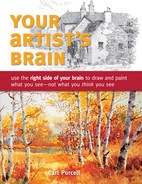CHAPTER 9
seeing the SHAPE OF SPACE

LOW TIDE IN POLPERRO
![]() Watercolor
Watercolor ![]() 14″ × 19″ (36cm × 48cm)
14″ × 19″ (36cm × 48cm)
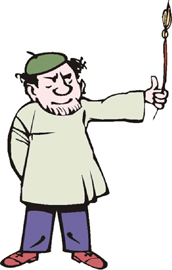
Your ability to compose or design paintings is inseparably connected to your ability to see shapes. As you discovered in the drawing section, the shapes of the space around the objects you see are equally as important as the shapes of the objects themselves. These shapes are a vital part of your painting. I prefer calling them “shapes of space” rather than negative shapes, because the former is a more positive reference — nothing about them is negative! They are one of the most positive design aspects with which you can work.
Instead of “negative” painting, think of it as defining objects by painting the space around them. Your intellectual brain wants you to believe that everything needed to define any object is within or on the object. This is false. Often the most revealing detail is at the edge of a form where the surrounding space defines it.
Designing shapes of space
If we think of the space around an item as a space shape, it doesn't matter what it is specifically. Therefore, I consciously try to design the shape of the space around any object. Sometimes it is part of a larger object, or it may just be sky. The important aspect is to see it as a shape. Whether it receives a lot of color, texture and detail, or whether it is a simple wash, it is still one of the shapes in the painting.
Following are good reasons to make the shapes of space part of your thinking:
![]() They share an edge with a positive shape. If the edge of the space shape is interesting, then the edge of the positive item also will be interesting.
They share an edge with a positive shape. If the edge of the space shape is interesting, then the edge of the positive item also will be interesting.
![]() These spaces are easier to see as shapes than are nameable items, because we have no preconceived ideas about how they should look. This makes them easier to change. If we change the space shape, we automatically change the item shape.
These spaces are easier to see as shapes than are nameable items, because we have no preconceived ideas about how they should look. This makes them easier to change. If we change the space shape, we automatically change the item shape.
![]() Dealing with the space shape helps us avoid awkward tangents and boring shapes. A tangent occurs when a line touches another line but does not intersect it. For example, if the line from a distant hill coincides with the roof line of a building, it creates an awkward tangent because, at that point, the roof and the hill occupy the same space and one does not appear to overlap the other.
Dealing with the space shape helps us avoid awkward tangents and boring shapes. A tangent occurs when a line touches another line but does not intersect it. For example, if the line from a distant hill coincides with the roof line of a building, it creates an awkward tangent because, at that point, the roof and the hill occupy the same space and one does not appear to overlap the other.

WASH DAY ![]() Watercolor
Watercolor ![]() 14″ × 19″ (36cm × 48cm)
14″ × 19″ (36cm × 48cm)
Viewing Positive and Negative Shapes
If the sky is a negative (or space) shape and the buildings are positive shapes, then what do we call the shape of dark around the clothesline? The positive shape just became a negative shape. The sky is a light space shape, and the buildings become a shape of dark space around the clothesline.
![]() The shape of space often defines the character of the positive items. For example, if you correctly draw the shape of space between a figure's arm and torso, you've automatically drawn the edge of the arm in relationship to the torso.
The shape of space often defines the character of the positive items. For example, if you correctly draw the shape of space between a figure's arm and torso, you've automatically drawn the edge of the arm in relationship to the torso.
![]() Drawing the shape of the space around an item is often easier than drawing the item itself. It helps us avoid mistakes in drawing that are the result of the intellectual brain, which substitutes stored knowledge for visual facts. This is especially true when drawing the human figure or other subjects where perspective presents us with a foreshortened view.
Drawing the shape of the space around an item is often easier than drawing the item itself. It helps us avoid mistakes in drawing that are the result of the intellectual brain, which substitutes stored knowledge for visual facts. This is especially true when drawing the human figure or other subjects where perspective presents us with a foreshortened view.

COMING HOME IN CLOVELLY Watercolor 21″ × 14″ (53cm × 36cm)
Positive Shapes Can Act as Shapes of Space
I painted this in the quaint North Devon coastal fishing village of Clovelly in England. While walking down the stone steps, I looked back and saw the light falling on them. The white shape of the building at the top captivated me. The two ladies who came home while I was painting were the icing on the cake.
The white shape of the building actually functions as a space around the dark figure. The doorway becomes a dark shape of space behind the other figure. This is an example where the positive shape of a building becomes a negative shape when a figure is painted over it. Consider the space around any object as a shape for you to design — it is as important as the shape of the object. Do you see how the light shape interacts with the darker shape?
Make the shape of space enhance your subject
Remember how the small space is between the finger of God and the finger of Adam in Michelangelo's painting of the creation of Adam in the Sistine Chapel? That tiny space creates an enormous tension that seems to spiritually unite God and Adam. Shapes of space possess that intensity of electric energy. Negative space can either unite two items with dynamic tension between them, or it can push them apart with the same force.
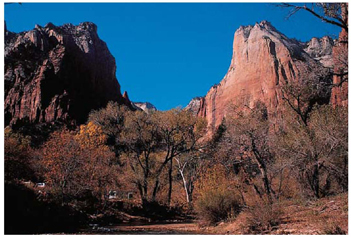
Negative Space Repels Structures
This is one of my favorite spots to paint in beautiful Zion Canyon in southern Utah. Notice how the space between the two towering rock formations seems to push them away from each other. This is because the space shape between them is as large as the positive rock forms. The energy in the space is a force driving the two forms apart.
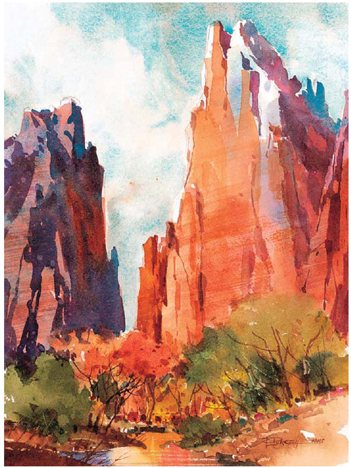
ZION CANYON ![]() Watercolor
Watercolor ![]() 13″ × 10″ (33cm × 25cm)
13″ × 10″ (33cm × 25cm)
Shrinking Negative Space Helps Subjects Work Together
I made several small changes to this subject, but the major enhancement was simply making the space shape between the rocks smaller than the peaks. Now the two are working together. The space between them becomes a dynamic one that seems to pull the two together, rather than an empty space forcing them apart. Space then is not “nothing” it is energy and force. This is a life principle. Often the little things in a relationship that seem to have no substance can end up becoming so large that they drive two people apart. Make the space work for you by creating energy of attraction between subjects.

Reference Photo
This old mine has a very interesting shape; however, there are a few problems. There are two shapes of space behind the subject: the sky and the hill. The trees along the top of the hill create a line between them that does nothing for the subject — in fact, it takes attention away from the subject. Also, by just kissing the top of the A-frame, the hill creates an awkward tangent. The other space-shape problem here is the abundance of space around the sides and bottom of the subject. The subject ends up floating in this space instead of being defined by it. Beginning painters often encounter this problem. By not considering the shape of the surrounding space, you are forced to surgically amputate the excess parts of the painting after it's completed.
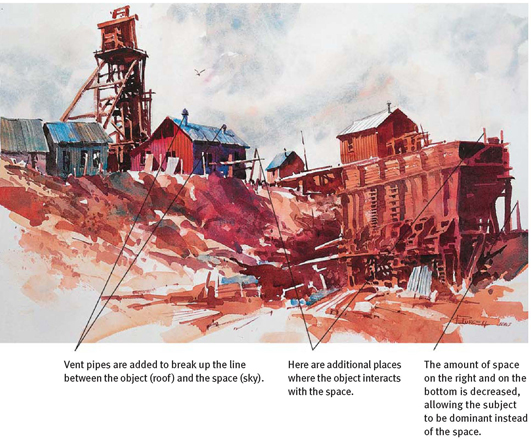
HORN SILVER Watercolor 14″ × 28″ (36cm × 71cm)
Problems Solved
Here I have consciously considered the shape of the space around the subject. Eliminating the hill created one background space shape that now shares an edge with the subject. I also made a few adjustments to the space shape by adding a few poles to create more places where the subject's shape interacts with the space. I moved the right edge of the painting closer to the subject shape to create an interesting ending to the space shape. I added some vent pipes on the buildings to break up the line between space and subject shape. I also decreased the space at the bottom. Now the shape of the subject activates the space by touching the sides and bottom of the painting.
Combine photos to create ideal shapes
An artist's duty does not involve painting scenes just as they are. Painters aren't recorders. It is more important for you to express what you feel about your world. A camera can record exactly what is there, but only you can record your perceptions and feelings about a subject.
My best advice is to be passionate about painting and get in touch with that passion. Look at a subject and see the possibilities for a painting. If you look for the perfect composition, you will do a lot of searching and a little painting. Once you realize that you are free to rearrange and edit the material, you will smash the shackles of copying and revel in your freedom of expression.
The possibility of a painting often stems from a combination of elements in two or three photos I have taken. This new reality looks the way I wish the scene had looked. Here's how it works.

Reference Photos
Here is a photo of a wonderful rock formation, and another that focuses on a juniper tree in the same desert scene. This scene has some very good points and one very big problem. Notice that in the first photo, the line that divides the space shape of the sky from the shape of the rocks is almost perfectly straight. The line is broken only once by the tree form.
Now imagine the sky shape coming around the main rock form. What would that do to the rocks? Let's see.

Rough Sketch
Roughly sketch the scene to see how combining the two photos would look. This is just a quick thumbnail to “try on” the composition; if it doesn't work, do another. Even in this rough draft we can see the dynamic potential of the scene without that bothersome continuous line. The combined references make a good composition with interesting shapes, so let's take it one step further.
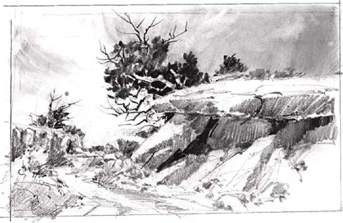
Final Sketch
Let's plan the composition some more. Borrow a better tree from the second photo because it has a more irregular configuration and interacts with the surrounding space. Now do another more complete drawing. Everything should help draw your eye to the point where the rock meets the tree, the focal point of the painting. With this plan, the painting has a much better chance of success.
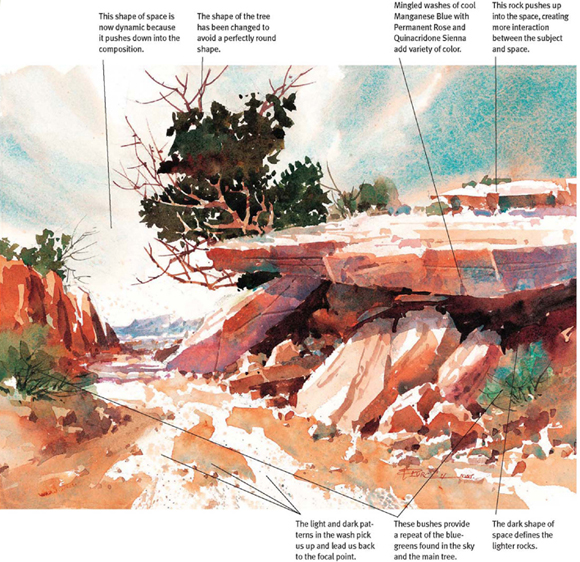
TRIUMPH OF LIFE ![]() Watercolor
Watercolor ![]() 10″ × 13″ (25cm × 33cm)
10″ × 13″ (25cm × 33cm)
Finished Painting
I have always felt drawn to these trees that seem to defy all odds and grow where nothing else could. To me they are symbols of the tenacity and power of life. The changes made to the composition support this theme.
